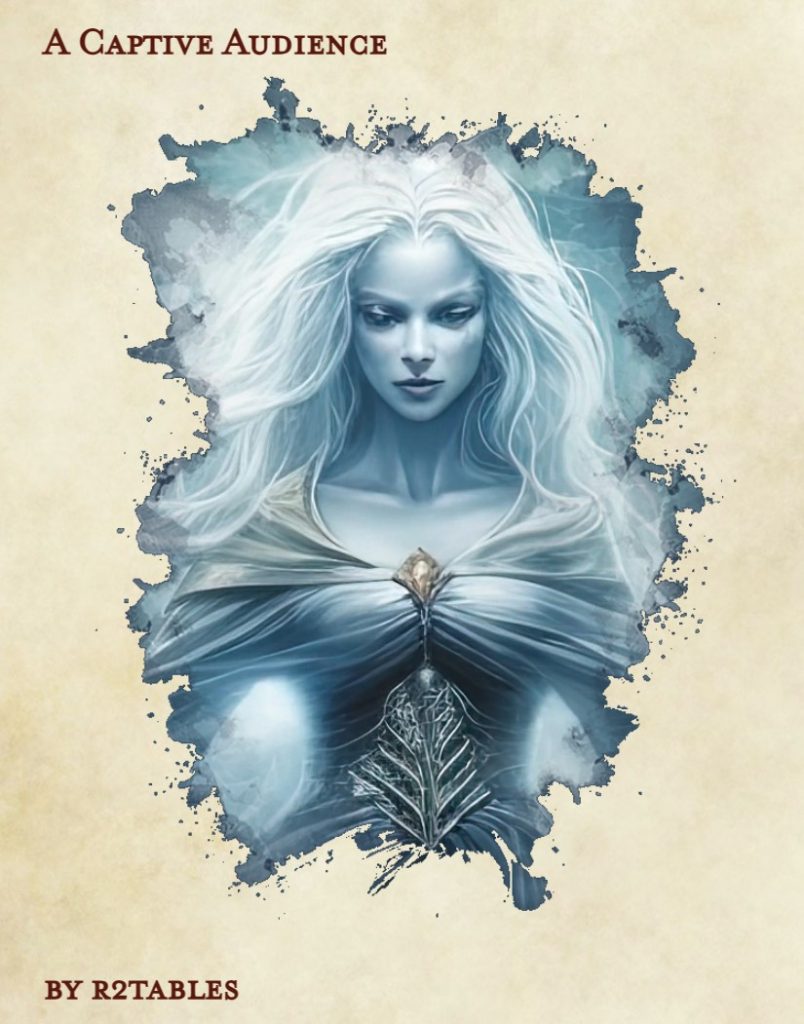My First Published Encounter

For a while now I’ve wanted to dabble in publishing adventures. As I mentioned in a recent post, last year I enrolled in an online Write Your First Encounter course which focused on creating a one-page work that can be easily dropped into a campaign. What follows is a little of my thought process while writing it and a description of what resulted.
In addition to the requirements implied within the structure of the course, I had a couple of objectives of my own:
- There should be a variety of ways to resolve the encounter, not all of which require combat – and in fact the non-combat solutions could lead to the best outcomes.
- There should be multiple opportunities for the GM to spawn further quests or encounters from this one.
I targeted a D&D 5e audience at first, with plans to release versions for a few other games later. The main character the story revolves around is a banshee-like creature named Felor. Making her a modified banshee both helped set the level range for the adventure and saved me a lot of space on the page by not having to show a full stat block, only reference the Monster Manual version and note where Felor differed.
The Source of the Story
The inspiration for the scene itself came from a couple of places.
First, there was a set of miniatures I painted a while back that I really wanted to use as NPCs in a game but still hadn’t gotten around to. They’re a trio of trolls with musical instruments, accompanied by a stone-golem lead singer; I’ve taken to referring to them as “Petty Thom and the Heart-Eaters”.
Secondly, at the time this was being written I was in the process of discovering a Dutch singer named Floor Jansen and the amazing things she can do with her voice. (This song is a good sampler, and this one features the sort of epic high notes that inspired a banshee-like character.)
From these two points I arrived at a conflict between the band and the banshee – one that would put innocents in jeopardy (as well as ruining the concert the player characters had been given free tickets to see)!
Tools and Resources
I chose to use The Homebrewery for the layout. It doesn’t have the fancy interface of full-blown publishing tools; in fact, using it might seem a lot like writing code to some – down to possibly needing to understand HTML styles. I’m already fairly comfortable in that world and the default styling in the tool is pretty good for a 5e supplement. For more complex projects in the future I’ll probably have to spend some time investigating more fully-featured desktop publishing software.
I wanted to have at least a little bit of art in the project and found an Etsy seller who’d created a digital image that was perfect for Felor. I contacted the seller to see if there was a way to use it commercially, on the off chance it was something not too expensive to justify for the project. Luckily I was given permission to use it as long as I purchased the regular version from the shop. If I remember correctly, it was something like $7 as part of a bundle with several other images.
With my layout created and a PDF file generated, there was a bit of back-and-forth with DMs Guild to make sure I had all the license details worked out, my 5e encounter was published on DriveThruRPG!
More Systems, More Better
So my encounter was published for 5e… but I wasn’t running or playing 5e at the time! I wanted to create versions for other systems as well, without having to invest time and money buying and learning new games. At the time I had recently embarked on running my first Pathfinder 2 campaign and was doing sporadic one-shots in EZD6 as well, so I wanted to branch out to cover those systems.
For the Pathfinder version, I found a layout template for Pathfinder-like styling in HomeBrewery – though it appears to no longer be available. Because the banshee is a much more powerful entity in PF than in D&D, I needed to follow the PF2e rules for monster creation to build a lower-potency entity. The need to include a stat block would force the adventure to use a 2-page layout, but I could live with that. I also had to adjust some saving throw target numbers and skill names to be more PF-appropriate.
The EZD6 version required more work. There was a bit more restructuring needed to work in mechanisms from that system that don’t map directly to skills and saves common to those D20 systems, along with havng to create an appropriate new stat block for Felor.
But I wanted to style it in a way that was reminiscent of the published official materials for the game and compliant with the OpenEZD6 license. After consulting with DM Scotty to make sure it was okay to do, I created a HomeBrewery template for EZD6 and made it available to the public. (More on that in another post!)
To save space in the layout of the three different versions of the encounter, I moved the licensing information into a separate text file. And while it wasn’t really necessary, I included a map image of The Henge – the concert venue in question – and a VTT token of Felor. I bundled all this into a single package containing all three versions and uploaded it in place of the 5e-only version, all for the same price.
Blatant Self-Promotion
You knew this was coming!
Pingback: Blog Updates and Too Many Projects Syndrome – (Re) Turning (to) the Tables